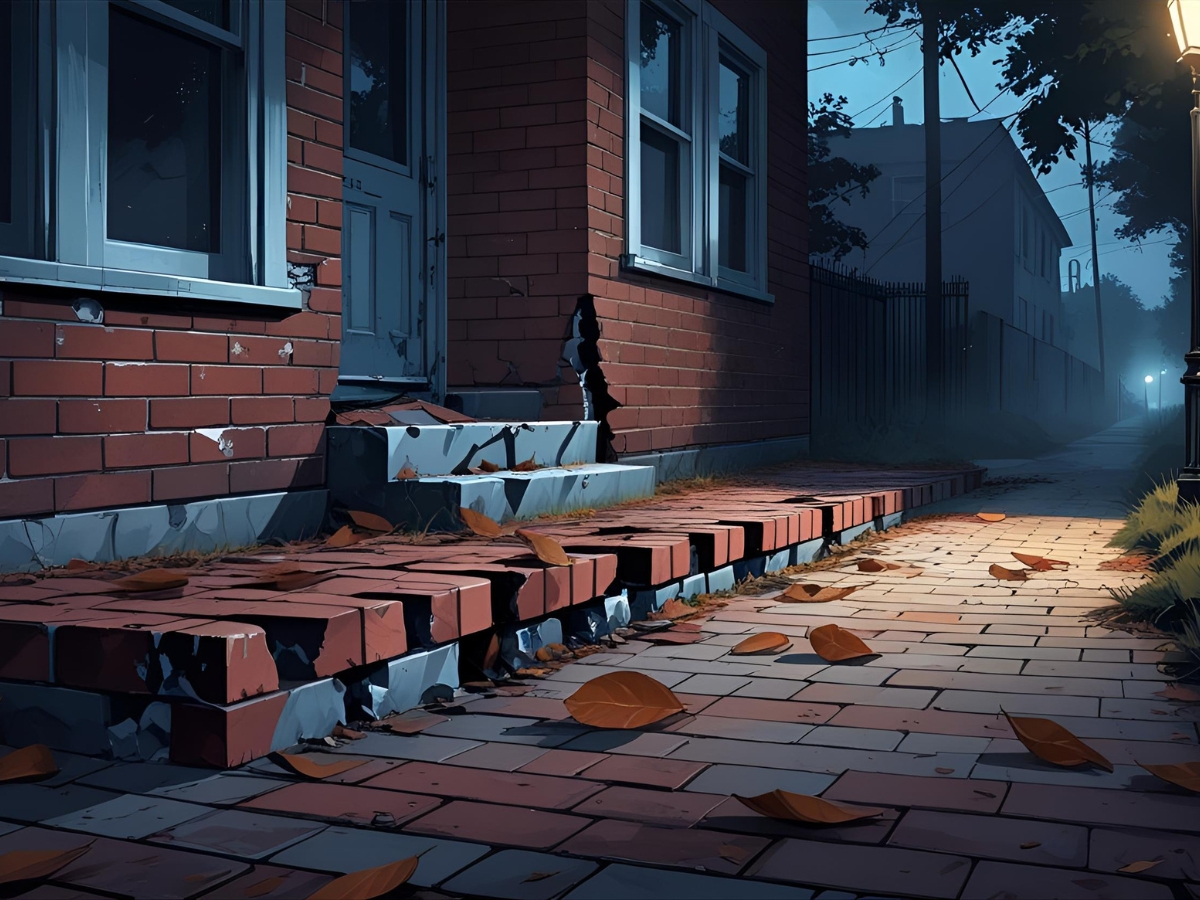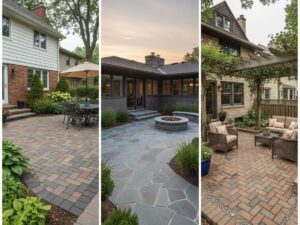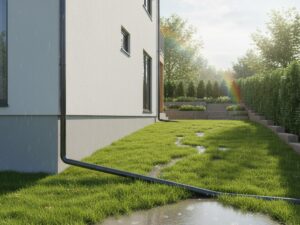Brick pavers are built to last, but they’re not immune to the effects of time, weather, and use. The tricky part? Knowing whether those signs call for a simple brick paver repair or a full replacement. While some issues, like minor settling or loose joints, can be easily fixed, others, like deep cracks or widespread sinking, may signal it’s time to start fresh. Making the right call can save you thousands and extend the life of your outdoor space.
In this blog, we’ll walk through some key signs your pavers might be trying to tell you something, and help you decide if repair or replacement is the smarter move.
What Are the Main Causes Behind the Brick Pavers’ Damage?
Here are the key brick paver damage indicators that call for brick paver repair or replacement:
Poor Installation
One of the biggest reasons brick pavers get damaged is poor installation. If the base layer under the pavers isn’t properly compacted or leveled, it can lead to uneven settling over time. This results in sunken areas, raised edges, or shifting bricks. Skipping essential steps like using edge restraints or failing to set the pavers tightly together also increases the chances of movement and misalignment. A solid foundation is absolutely critical; without it, the surface won’t stay stable for long.
Water Drainage Issues
Water is one of the most common causes of paver problems, especially when drainage isn’t handled correctly. If water collects underneath or around the pavers, it gradually erodes the sand base or causes the soil to shift, making the bricks sink or shift. In addition, pooling water can encourage algae and mildew growth, which is one of the most significant brick paver deterioration signs and results in making surfaces slippery and unattractive. In the long run, improper drainage leads to structural issues and shortens the lifespan of your paved surface.
Freeze-Thaw Cycles
In colder climates, the freeze-thaw cycle can wreak havoc on brick pavers. When water seeps into small gaps or beneath the pavers and then freezes, it expands. This expansion creates pressure, causing the bricks to crack, lift, or even break. When temperatures rise and the ice melts, the structure weakens further. Over many seasons, this cycle of freezing and thawing can cause serious, often costly, damage to paved surfaces.
Tree Roots and Vegetation
The natural growth of tree roots and other vegetation beneath the pavers can slowly but steadily push the bricks out of alignment. Tree roots in particular are strong and persistent; they grow toward moisture and can lift pavers from below, causing bulging or cracking. Weeds and grasses that sprout up between paver joints may seem harmless at first, but over time, they widen gaps and compromise the stability of the surface.
Heavy Loads or Traffic
Constant exposure to heavy loads, such as parked vehicles, delivery trucks, or machinery, can strain brick pavers over time. If the pavers aren’t rated for vehicle use or the base layer isn’t properly reinforced, this can cause ruts, sinking, or cracking. One of the most crucial driveway brick paver selection tips is to choose high-strength pavers specifically designed for vehicular traffic and ensure the sub-base includes compacted gravel and proper edge restraints.
Severe Weather or Natural Disasters
Extreme weather events such as floods, hurricanes, or earthquakes can lead to major brick paver damage. These natural forces often result in large-scale shifting, erosion, or even complete upheaval of paved surfaces. Even less extreme events, like heavy downpours or sudden temperature changes, can put stress on the structure.
De-Icing Salts and Harsh Chemicals
While de-icing salts and chemical cleaners can be convenient, they can also be very damaging to brick pavers. These substances often contain chlorides or other corrosive compounds that eat away at the paver surface and degrade the joint sand. Over time, this leads to pitting, fading, and cracking.
Brick Pavers Need Repair or Replacement: Warning Signs?
Here are the most important warning signs that call for either brick paver repair or replacement, along with effective brick paver damage hacks:
Uneven or Sunken Pavers – Likely Need Repair
- Cause: Poor base preparation, water erosion, or settling of the ground beneath.
- Significance: Creates trip hazards and drainage issues.
- Solution: Often can be repaired by lifting, re-leveling the base material (like sand or gravel), and relaying the same pavers.
Cracked or Broken Pavers – Repair or Replace Individual Units
- Cause: Heavy loads, freeze-thaw cycles, or poor-quality pavers.
- Significance: Structural weakness, aesthetic issues.
- Solution: If isolated, Replace individual damaged bricks. In case widespread, it may indicate poor material or sub-base, requiring larger-scale replacement.
Pooling Water or Drainage Issues – Base May Need Repair
- Cause: Improper grading or clogged joints.
- Significance: Water damage, moss/algae growth, freeze-thaw damage in cold climates.
- Solution: Regrading or re-leveling. If drainage design is flawed, replacement with proper slope and drains may be needed.
Loose or Shifting Pavers – Sign of Base or Edge Restraint Failure
- Cause: Edge restraints failing or insufficient compacting during installation.
- Significance: Pavers won’t stay in place, leading to gaps and more damage over time.
- Solution: Re-secure edge restraints and re-compact the base if needed. Usually repairable.
Weed Growth Between Joints – Maintenance or Joint Repair
- Cause: Deteriorated polymeric sand or infrequent maintenance.
- Significance: Cosmetic concern; roots can widen joints or dislodge pavers over time.
- Solution: Remove weeds, clean joints, and reapply polymeric sand. Not a sign for full replacement.
Widespread Discoloration or Efflorescence – Aesthetic but Manageable
- Cause: Water reacting with salts in concrete pavers, or UV exposure.
- Significance: Mostly cosmetic unless caused by water damage.
- Solution: Clean with efflorescence removers, sealers. No structural brick paver repair is usually needed.
Age of the Paver System – Lifespan Evaluation
- Fact: Brick pavers generally last 25–50 years depending on quality and maintenance.
- Warning Sign: If you see multiple systemic issues in a 20–30+ year-old installation, full replacement might be more cost-effective.
- Evaluation Tip: Compare long-term maintenance costs vs. one-time replacement.
Heaving from Tree Roots or Frost – May Require Partial or Full Replacement
- Cause: Root growth lifting the base, or frost heave in cold climates.
- Significance: Disrupts level surface, causes cracks and instability.
- Solution: Remove root interference or install a proper frost-resistant base. May require replacing affected sections.
Dirty or Stained Pavers – Typically Maintenance, Not Replacement
- Cause: Oil, rust, mold, or mildew buildup.
- Significance: Aesthetic rather than structural.
- Solution: Power washing, applying paver cleaner or stain remover. Sealing can prevent future stains.
Loose Joint Sand or Erosion – Re-sanding Required
- Cause: Weather, improper installation, or poor-quality polymeric sand.
- Significance: Can lead to shifting, weed growth, and water penetration.
- Solution: Sweep in new joint sand or polymeric sand and compact.
Why Professional Brick Paver Contractors Can Make a Difference?
Knowing brick paver repair tips isn’t enough; for quality work, you need expert help. Hence, hiring professional brick paver contractors ensures precise installation, long-lasting durability, and proper drainage, key factors that prevent costly brick paver repairs. Experts assess soil conditions, use quality base materials, and ensure correct compaction, which minimizes shifting, cracking, and water pooling. Professionals also follow design best practices, ensuring both functionality and aesthetic appeal. Their access to specialized tools and proven techniques saves time and avoids common DIY mistakes. Ultimately, professional installation protects your investment and adds long-term value to your property.
Confused about how to find the best brick paver patio contractors? Choose My Landscape Contractors, your trusted partner in transforming outdoor spaces with precision and care. We combine craftsmanship, durability, and design expertise to create stunning patios, walkways, and driveways that stand the test of time.




